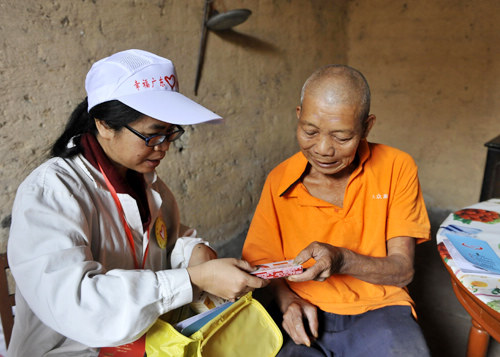|
 |
|
MEDICAL AID: A volunteer distributes free medicine to a farmer in poverty-stricken Huangla Village, Guangdong Province on November 20 (CHEN YEHUA) |
China has dramatically lifted its official poverty line to an annual per-capita income of 2,300 yuan ($359.4) in rural areas as part of the government's efforts to distribute the fruits of the country's economic growth to a wider section of its population.
The decision by central authorities to raise the poverty threshold by over 90 percent from the 1,274 yuan ($199.1) standard set in 2010 was announced at a national poverty alleviation meeting on November 29.
The sharp increase brings China's poverty line closer to the international standard of $1.25 a day, which was established by the World Bank in 2008. According to the official Xinhua News Agency, China's poverty threshold is actually higher than the World Bank's standard if measured at purchasing power parity.
A government white paper on poverty reduction released in early November shows that the country reduced the poverty-stricken population of its rural regions to 26.88 million at the end of 2010 from 94.22 million a decade ago. According to the white paper, China increased its spending on poverty reduction from 12.75 billion yuan ($1.99 billion) in 2001 to 34.93 billion yuan ($5.46 billion) in 2010, representing an 11.9-percent average annual increase. Total spending on poverty reduction during the 2001-10 period was 204.38 billion yuan ($31.9 billion).
The new poverty line will increase the population eligible for government poverty-relief subsidies to 128 million, or 13.4 percent of the rural population and nearly one 10th of the nation's total population.
Speaking at the November 29 meeting, President Hu Jintao said, "By 2020, our general target is to ensure that the nation's impoverished will no longer need to worry about food and clothing. Their access to compulsory education, basic medical care and housing will also be ensured."
Hu also announced the government's plan to lift the annual net income growth of farmers in poverty-stricken regions above the national average by 2020, bring the quality of public services enjoyed by the poor to near national levels and reverse the trend of a widening rich-poor gap.
"The drastic increase of the existing poverty gauge shows that the Chinese Government is pragmatic about the difficulties and challenges it faces in poverty reduction," said Zhuang Jian, senior economist at the Asian Development Bank, which is committed to fighting poverty in Asia and the Pacific. Zhuang said that instead of trying to reduce the number of people classified as poor, this adjustment of the poverty line indicated the government is genuinely interested in raising the quality of life of China's poorest citizens.
China's poverty line was split into two categories before 2008: one for absolute poverty, and the other for low-income families. At the end of 2008, the two were combined as one.
In 1986, the absolute poverty standard was an annual per-capita income of 206 yuan ($32.2). After several adjustments, the poverty line was raised to 1,067 yuan ($166.7) in 2008, 1,196 yuan ($186.9) in 2009 and 1,274 yuan ($199.1) in 2010.
China began its concerted large-scale anti-poverty drive in the mid-1980s. In 1994, it unveiled a plan that was designed to secure food supplies for 80 million rural residents over seven years. This marks China's first attempt to designate a specific target for poverty reduction.
According to the UN, 70 percent of the people who have been lifted from poverty worldwide over the past 25 years were Chinese.
"China's poverty reduction drive is unique in history. No other nation in history has ever been able to bring so many people out of poverty in such a short time," Napoleon Navarro, acting Country Director of the UN Development Program China, told Xinhua.
Speaking at a news conference in Beijing last September, UN Resident Coordinator in China, Renata Dessallien, said China had already achieved three out of the eight key benchmarks outlined in the Millennium Development Goals, which are intended to help the world's poorest by 2015. It has halved the number of people living on less than $1 a day, achieved universal primary education for children and reduced child mortality by two thirds.
"China's success in lifting millions of people out of poverty is unprecedented," Dessallien said.
| 